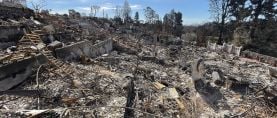
President’s Desk — November 2023
Technical knowledge is maybe half of what a cinematographer is made of, but one needs to be willing to put all of that into muscle memory and dive into the narrative unknown.

Over the past few months here at the ASC Clubhouse, I’ve been immersed in Society business, and hopefully helping to create a positive energy and provide a sense of community for everyone who walks through the door. I have never ceased to be amazed by the creative perspectives our members can access consistently. We’ve recently had our share of technical events and presentations that delve into the world of lenses, digital techniques, AI, virtual production, high-dynamic-range imagery, and so on. For our members, the conversations about these technologies — which otherwise might look hopelessly scientific to an outsider — swing quite quickly to their narrative and storytelling attributes. How can we use technical tools and techniques creatively (sometimes in ways they may not have been designed to be used) to make a screen moment resonate?

When I was coming up as a cinematographer, the technical side of the job seemed quite daunting. There was so much to learn … and gaining an understanding of image construction in the photochemical days was slow and methodical. But during that period, we established relationships with labs, camera suppliers, film manufacturers and lighting companies. The need for collaboration was evident in one’s first attempt to learn where the film turned from deep shadow to black, and equally apparent in the cooperative testing that was required to get that information into our young minds.
Early on, I was fortunate to meet Allen Daviau, ASC, who mentored me for 45 years before passing away in 2020. I learned a lot from him — but, most importantly, from his personification of the type of individual one needed to be if you wanted to live your life as a director of photography. Allen embodied generosity with his positive attitude and kind nature. I remember one conversation with Bill Butler, ASC, who said he felt he was selected for certain projects over more qualified cinematographers because his temperament was more conducive to creating positive energy. This is a real thing — especially now, when bravado will take you down a shorter path than sincerity.
It’s all too easy to get lost in the technical weeds. I fell into this trap myself when I was asked to shoot the third Jurassic Park film in 1999. The project was large, and I felt I needed advice. Janusz Kamiński came to the fore after a brain-melting early visit to the Stan Winston Studio. Stan gave me access to fully painted maquettes of our dinosaurs that I could test under the type of jungle lighting I was proposing. I phoned Janusz, who listened to me inquire about paint finishes, light reflection and incident color. Halfway through my semi-panicked list of questions, I heard Janusz saying, “Stop. Stop. You don’t need to worry about any of this. You are working with the top department heads in the industry and they’re going to give you the best. Your job is to give these creatures a world they can live in.”
Technical knowledge is maybe half of what a cinematographer is made of, but one needs to be willing to put all of that into muscle memory and dive into the narrative unknown — and put one’s heart and soul onto the screen.
Best regards,
Shelly Johnson
ASC President





